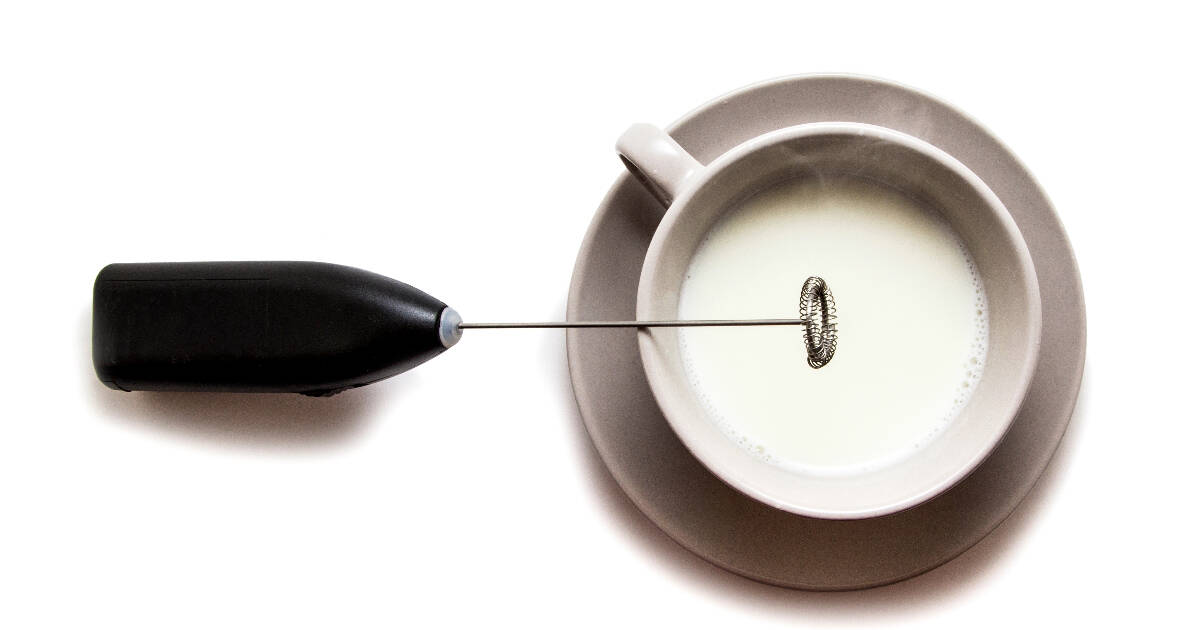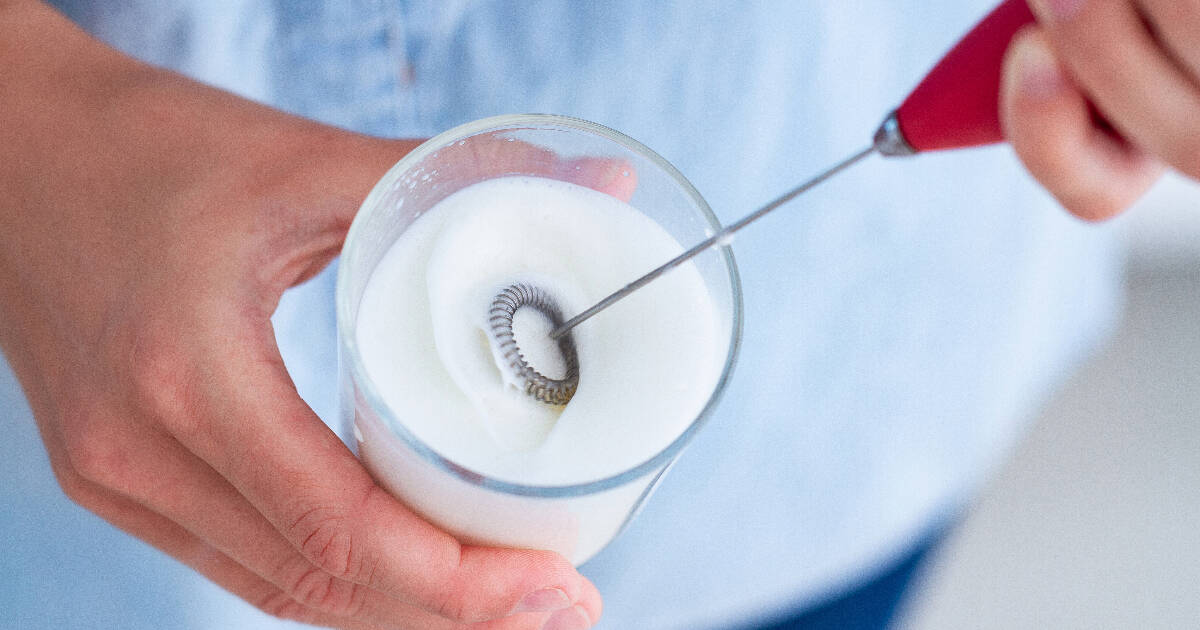Frothy, foamy milk is what makes drinks like lattes, cappuccinos, and macchiatos so delicious. While baristas make it look easy, frothing milk to cafe-quality at home can be tricky for beginners.

But with the right milk frother wand and some practice, you'll be making specialty coffeehouse drinks in your own kitchen.
Selecting and Preparing Milk for Frothing
When learning how to use a milk frother wand, the first step is selecting and preparing the right milk. Fresh milk works best, so check expiration dates and use milk that has been recently purchased. Whole milk contains the highest fat content, which helps the milk foam up thicker and creamier. However, it can be more difficult to froth whole milk initially. If you're new to frothing, start with skim milk - it's more forgiving and easier to create foam with.
Only fill your frothing pitcher or carafe about one-third full with milk. Milk doubles in volume when frothed, so leaving much room is crucial to avoid overflow and mess. Make sure to use cold milk straight from the refrigerator, as warmer milk won't foam up as thick and fluffy. Heat the milk after frothing if you prefer a hot foam beverage.
Using a Handheld Frothing Wand

For battery-powered handheld frothing wands, begin by holding the wand vertically with the whisk head fully submerged in cold milk. Turn on high speed. Create a circular swirling motion for 30 seconds until bubbles start to form.
Then change to moving the wand up and down while keeping the head submerged for another 30 seconds. The foam will become thicker and creamier. When satisfied with the consistency, turn off the wand and tap gently on the side of the cup or carafe to knock off any excess foam. The milk is now ready to heat and serve.
Tips for Frothing with a Steam Wand
Steam wands on espresso machines allow excellent control when hand-crafting specialty coffee drinks. Begin by filling a frothing pitcher only one-third full with cold milk straight from the fridge. Switch the espresso machine to steam mode so the wand begins heating up.
Purge the wand by briefly running steam through it into an empty cup or drip tray. This clears out any residual water before steaming the milk. Insert the steam wand tip just below the milk's surface to aerate and create microfoam bubbles. For hot milk, submerge the wand deeper into the milk's center, tilting the pitcher to create a swirling vortex for even heating.
When desired temperature and froth are achieved, turn off the steam mode and remove the wand from the milk. Gently tap the pitcher on the counter to knock out excess large bubbles and settle the foam. For drinks with defined foam layers like cappuccinos, avoid swirling the milk after tapping to preserve layered texture.
Frothing Milk Manually
If using a manual milk frother, also called a French press style frother, start by securely fastening the lid. Hold the carafe steady with one hand and pump the plunger vigorously up and down with your other hand for 30 seconds. It will become more difficult to pump as foam develops.
After 30 seconds, check foam consistency. Continue pumping for 30-second intervals until desired foam is achieved. Avoid over-pumping for more than 1 minute total, as it can cause the foam bubbles to break down.
When finished pumping, remove the lid and tap the whisk end on the carafe rim to knock off excess foam back into the milk. Give the carafe one gentle circular swirl to incorporate foam, then it's ready to heat and use.
Milk Varieties and Frothing Ability
The variety of milk used will impact frothing results. Whole milk takes a bit more time but creates deliciously thick, creamy foam. Skim milk froths very quickly into light, airy foam that's easy to overwhip. Non-dairy milk like almonds and oat can also be frothed but may have less stability in the finished foam.
No matter what milk you use, always start with it cold from the refrigerator before frothing. Heating milk first can cause proteins to denature, resulting in less froth stability. The friction from frothing introduces some heat already, so cold milk helps counter that warming effect.
Serving Frothed Milk in Coffee Drinks

Once your milk is frothed, it can be used in a variety of delicious coffee and espresso beverages. Gently microwave for 30-40 seconds until the desired temperature is reached, checking often to avoid overheating. Then use a spoon to carefully dollop frothed milk on top of brewed coffee or espresso.
For layered drinks like cappuccinos, reserve some thick foam in the frothing pitcher to spoon over last. When adding milk and foam to coffee, pour slowly and gently to maintain the airy, bubbly texture of the froth. Now you can enjoy homemade lattes, mochas, macchiatos, and more!
FAQs
What is the difference between frothing and steaming milk?
Frothing introduces air into milk through vigorous agitation to create bubbly foam and increase volume. Steaming uses hot high-pressure steam to aerate milk and also heat it at the same time. A steam wand on an espresso machine can do both simultaneously.
Should I buy whole milk or skim milk for frothing?
Whole milk will give you rich, creamy foam while skim milk froths faster into lighter, airier bubbles. Try starting with skim milk while learning to get the hang of frothing, then switch to whole milk for indulgent foam once you've mastered the technique.
How do I know when the milk is frothed enough?
Stop frothing when the milk has about doubled in volume. For lighter foam, froth for a shorter time. For thicker, creamier foam let it continue aerating until the bubbles are at your desired consistency. Automatic frothers will turn off when done.
Can I use non-dairy milk like almond or oat milk?
You can froth nut and plant-based milk, but they won't achieve quite the same results as dairy milk. Look for barista-style varieties formulated specifically for frothing. Move the frother quickly to avoid over-aerating the milk.
Conclusion
With the right milk frother wand and some practice, you'll be steaming and frothing like a pro.
Use fresh cold milk and fill your frothing pitcher only partway.
Move the wand in circles for light foam or pump vigorously for thicker foam.

